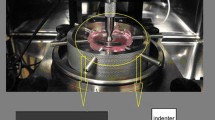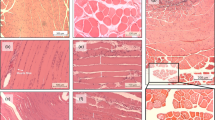Abstract
Deep pressure ulcers develop in tissues subjected to sustained mechanical loading. Though it has been hypothesized that this damage mechanism results from local tissue ischemia, it has recently been shown with a cell model that sustained compression can cause cell deformation, leading to tissue breakdown. The present study focuses on the assessment of cell viability during compression and ischemia in an in vitro muscle model to determine their relative contributions to damage development. A model system was developed consisting of engineered skeletal muscle produced from the culture of murine muscle cells in a collagen gel. The tissue was subjected to 0, 20, or 40% compression under hypoxic or normoxic conditions. Experiments were performed on the stage of a microscope and cell viability was monitored using fluorescent markers for apoptotic and necrotic cell death. Hypoxia did not lead to significant cell death over a 22 h period. By contrast, compression led to immediate cell death that increased with time. No additional effect of hypoxia on cell death was observed. These data show that contrary to existing theories, compression can cause development of muscle damage and that hypoxia does not contribute to cell death development within 22 h in engineered muscle.









Similar content being viewed by others
References
Arthur P. G., Giles J. J., Wakeford C. M. (2000) Protein synthesis during oxygen conformance and severe hypoxia in the mouse muscle cell line C2C12. Biochim. Biophys. Acta 1475:83–89
Barbenel J. C. (1991) Pressure management. Prosthet. Orthot. Int. 15:225–231
Bliss M. R. (1998) Pressure injuries: Causes and prevention. Hosp. Med. 59:841–844
Bosboom E. M., Bouten C. V., Oomens C. W., van Straaten H. W., Baaijens F. P., Kuipers H. (2001) Quantification and localisation of damage in rat muscles after controlled loading; a new approach to study the aetiology of pressure sores. Med. Eng. Phys. 23:195–200
Bouten C. V., Knight M. M., Lee D. A., Bader D. L. (2001) Compressive deformation and damage of muscle cell subpopulations in a model system. Ann. Biomed. Eng. 29:153–163
Bouten C. V. C., Oomens C. W., Baaijens F. P., Bader D. L. (2003) The etiology of pressure ulcers: Skin deep or muscle bound? Arch. Phys. Med. Rehabil. 84:616–619
Bouten C. V. C., Breuls R. G. M., Peeters E. A. G., Oomens C. W. J., Baaijens F. P. T. (2003) In vitro models to study compressive strain-induced muscle cell damage. Biorheology 40:383–388
Breuls R. G. M., Bouten C. V. C., Oomens C. W. J., Bader D. L., Baaijens F. P. T. (2003) Compression induced cell damage in engineered muscle tissue: An in vitro model to study pressure ulcer aetiology. Ann. Biomed. Eng. 31:1357–1364
Bronneberg D., Bouten C. V. C., Oomens C. W. J., van Kemenade P. M., Baaijens F. P. T. (2006) An in vitro model system to study the damaging effects of prolonged mechanical loading of the epidermis. Ann. Biomed. Eng. 34:506–514
Brunelle J. K., Chandel N. S. (2002) Oxygen deprivation induced cell death: An update. Apoptosis 7:475–482
Byrne D. W., Salzberg C. A. (1996) Major risk factors for pressure ulcers in the spinal cord disabled: A literature review. Spinal Cord 34:255–263
Covington M. D., Bayless K. J., Burghardt R. C., Davis G. E., Parrish A. R. (2005) Ischemia-induced cleavage of cadherins in NRK cells: Evidence for a role of metalloproteinases. Am. J. Physiol. Renal Physiol. 289:F280–F288
Daniel R. K., Priest D. L., Wheatley D. C. (1981) Etiologic factors in pressure sores: An experimental model. Arch. Phys. Med. Rehabil. 62:492–498
Dinsdale S. M. (1974) Decubitus ulcers: Role of pressure and friction in causation. Arch. Phys. Med. Rehabil. 55:147–152
Garber S. L., Rintala D. H. (2003) Pressure ulcers in veterans with spinal cord injury: A retrospective study. J. Rehabil. Res. Dev. 40:433–441
Gawlitta D., Oomens C. W. J., Baaijens F. P. T., Bouten C. V. C. (2004) Evaluation of a continuous quantification method of apoptosis and necrosis in tissue cultures. Cytotechnology 46:139–150
Gefen A., Gefen N., Linder-Ganz E., Margulies S. S. (2005) In vivo muscle stiffening under bone compression promotes deep pressure sores. J. Biomech. Eng. 127:512–524
Husian T. (1953) An experimental study of some pressure effects on tissues, with reference to the bed-sore problem. J. Pathol. Bacteriol. 66:347–358
Jiang B. H., Semenza G. L., Bauer C., Marti H. H. (1996) Hypoxia-inducible factor 1 levels vary exponentially over a physiologically relevant range of O2 tension. Am. J. Physiol. 271:C1172–C1180
Kosiak M. (1959) Etiology and pathology of ischemic ulcers. Arch. Phys. Med. Rehabil. 40:62–69
Meldrum K. K., Meldrum D. R., Hile K. L., Burnett A. L., Harken A. H. (2001) A novel model of ischemia in renal tubular cells which closely parallels in vivo injury. J. Surg. Res. 99:288–293
Miller G. E., Seale J. (1981) Lymphatic clearance during compressive loading Lymphology 14:161–166
Nola G. T., Vistnes L. M. (1980) Differential response of skin and muscle in the experimental production of pressure sores. Plast. Reconstr. Surg. 66:728–733
Oomens C. W. J., Bressers O. F. J. T., Bosboom E. M. H., Bouten C. V. C., Bader D. L. (2003) Can loaded interface characteristics influence strain distributions in muscle adjacent to bony prominences? Comput. Methods Biomech. Biomed. Eng. 6:171–180
Portier G. L., Benders A. G., Oosterhof A., Veerkamp J. H., van Kuppevelt T. H. (1999) Differentiation markers of mouse C2C12 and rat L6 myogenic cell lines and the effect of the differentiation medium. In Vitro Cell Dev. Biol. Anim. 35:219–227
Prewitt R. L., Johnson P. C. (1976) The effect of oxygen on arteriolar red cell velocity and capillary density in the rat cremaster muscle. Microvasc. Res. 12:59–70
Reddy N. P., Cochran G. V. (1981) Interstitial fluid flow as a factor in decubitus ulcer formation. J. Biomech. 14:879–881
Reger S. I., McGovern T. F., Chung K. C. (1990) Biomechanics of tissue distortion and stiffness by magnetic resonance imaging In: Bader D. L. (ed), Pressure Sores: Clinical Practice and Scientific Approach. London: The Macmillan Press, pp. 177–190
Reswick J. B., Rogers J. E. (1976) Experience at Rancho Los Amigos hospital with devices and techniques to prevent pressure sores In: Kenedi R. M., Cowden J. M. (eds), Bedsore Biomechanics. London: The Macmillan Press, pp. 301–310
Richmond K. N., Shonat R. D., Lynch R. M., Johnson P. C. (1999) Critical PO(2) of skeletal muscle in vivo. Am. J. Physiol. 277:H1831–H1840
Scelsi R. (2001) Skeletal muscle pathology after spinal cord injury: Our 20 year experience and results on skeletal muscle changes in paraplegics, related to functional rehabilitation. Basic Appl. Myol. 11:75–85
Stekelenburg, A. The relative contributions of deformation and ischaemia to deep tissue injury. In Mechanisms Associated with Deep Tissue Injury Induced by Sustained Compressive Loading. Eindhoven University of Technology, PhD Thesis, 2005
Tsuji S., Ichioka S., Sekiya N., Nakatsuka T. (2005) Analysis of ischemia-reperfusion injury in a microcirculatory model of pressure ulcers. Wound Repair Regen. 13:209–215
Vandenburgh H., Del Tatto M., Shansky J., Lemaire J., Chang A., Payumo F., Lee P., Goodyear A., Raven L. (1996) Tissue-engineered skeletal muscle organoids for reversible gene therapy. Hum. Gene. Ther. 7:2195–2200
Wang Y. N., Bouten C. V. C., Lee D. A., Bader D. L. (2005) Compression-induced damage in a muscle cell model in vitro. Proc. Inst. Mech. Eng. [H.] 219:1–12
Acknowledgments
The authors thank Rob van den Berg and Harrie van de Loo for their contribution to the design and manufacturing of the experimental system. This research was supported by the Dutch Technology Foundation STW, applied science division of NWO and the Technology Program of the Ministry of Economic Affairs.
Author information
Authors and Affiliations
Corresponding author
Rights and permissions
About this article
Cite this article
Gawlitta, D., Li, W., Oomens, C.W.J. et al. The Relative Contributions of Compression and Hypoxia to Development of Muscle Tissue Damage: An In Vitro Study. Ann Biomed Eng 35, 273–284 (2007). https://doi.org/10.1007/s10439-006-9222-5
Received:
Accepted:
Published:
Issue Date:
DOI: https://doi.org/10.1007/s10439-006-9222-5




